Review of Isotope Hydrology Investigations on Aquifers of Cameroon (Central Africa): What Information for the Sustainable Management of Groundwater Resources?
Abstract
:1. Introduction
2. Study Site Description
2.1. Strong Hydroclimatic Diversity
- (i)
- The Guinean equatorial climate in the southern Cameroonian plateau with annual rainfall ranging between 1500 and 2000 mm and an annual mean temperature of 25 °C. The rainiest months correspond to March–April and September and the driest months are December–January and July–August.
- (ii)
- The equatorial maritime climate type extends from the southern coast and covers part of the western high plateau. The annual rainfall ranges from 2000 to 10,000 mm, being especially high where Cameroon’s volcanic massif comes close to the coast. Debundscha, with nearly 10,000 mm of rainfall per year, is the second-rainiest place on Earth after Chirapunji in India [12]. In this type, the nearness to the coast and the effect of the altitude on the southwest monsoon are responsible for the heavy annual rainfall [14]. The amount of rainfall decreases from the coastal areas towards the interior highlands, as shown by the data for Limbe (4000 mm) in the southeast of Mount Cameroon, Dschang (3000 mm) and Bamenda (2000 mm) in the western regions. Here, the rainfall distribution is unimodal, with the rainiest period from June to August. The average annual temperature for high altitudes is about 21 °C, while for low-lying coast, the annual average temperatures climb to 25.5 °C.
- (iii)
- Rainfall decreases northwards and the Sudan climate extends from the Adamawa Plateau to the 900 mm isohyet in the northern regions. Rainfall is spread just over four or five months, while the other months are dry. The mean annual temperature is about 28 °C.
- (iv)
- The Sudano-Sahelian type is the northernmost climatic type, extending from Maroua to the far-north border. It is characterized by a short rainy season and a marked dry season. Here, the rainfall ranges from 900 mm around Maroua to 500 mm around Kousseri, and 400 mm around the shores of Lake Chad. The mean annual temperatures are similar to those of the Sudan type, but the thermal amplitude is relatively high in comparison [14].
2.2. A Complex Geology and a Still-Underdocumented Hydrogeology
2.2.1. Geology
- -
- the Congo Craton (Archean age) in the south, made mainly of gneiss, granite and charnockite [15];
- -
- the Central African Mobile Zone (CAMZ; Pan-African age) in the north, which consist of remobilized Precambrian terrain including igneous and metamorphic rocks. The main rock types here are mica schists, micaceous gneisses, and migmatites intruded by quartz, diorite and granodiorites.
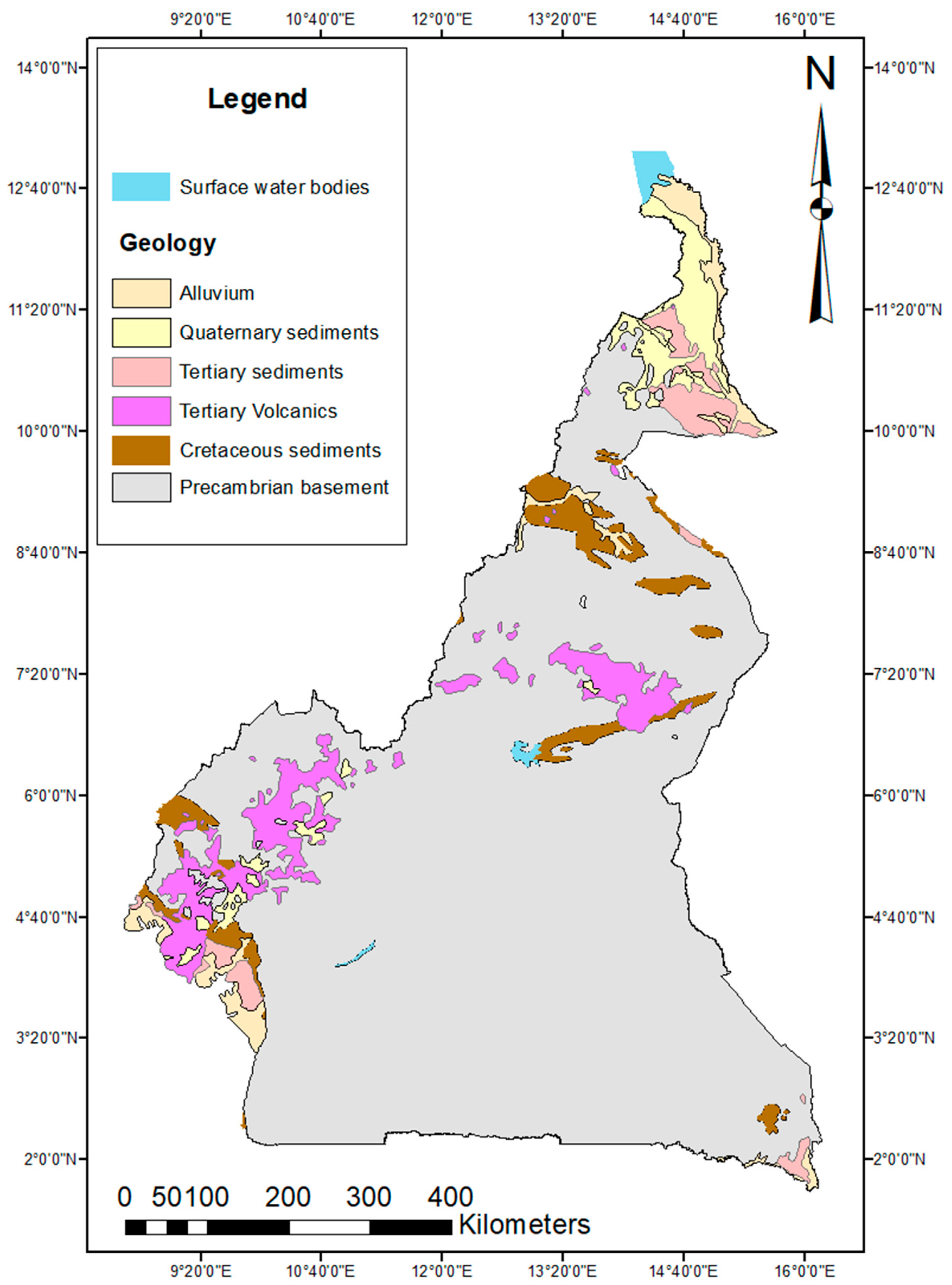
2.2.2. Hydrogeology
Basement Aquifers
Volcanic Aquifers
Unconsolidated Aquifers
3. Datasets, Methods and Analysis
4. Results and Discussion
4.1. Isotopic Signature of Precipitation
4.2. Spatial Pattern of Groundwater and Surface Water Isotopes: Inferring Groundwater Recharge Conditions
- (i)
- the samples below the LMWL and above the weighted mean precipitation, with an enriched signature, indicate a slow or an indirect infiltration of rainwater.
- (ii)
- cluster of samples close to the weighted mean precipitation and well on the LMWL, refers to an autochthonous recharge of the aquifer, also defined as diffuse recharge, i.e., direct infiltration of rain followed by percolation to the water table [44].
- (iii)
- For the third group, samples below the weighted mean rainfall and above the LMWL, the depleted signature here may be related to a MSR as this region is characterized by local hills, valleys and plateaus [21].
4.3. Identification of Strategic Paleo-Groundwater in Cameroon and Management Strategies for Such Resources
4.4. Necessary Future Isotopic Investigations to Cope with the Challenges of Development and Water Resources Protection
5. Conclusions
Supplementary Materials
Author Contributions
Funding
Data Availability Statement
Acknowledgments
Conflicts of Interest
References
- Gonfiantini, R.; Fröhlich, K.; Araguás-Araguás, L.; Rozanski, K. Isotopes in Groundwater Hydrology; Kendall, C., McDonnell, J.J., Eds.; Isotope Tracers in Catchment Hydrology; Elsevier: Amsterdam, The Netherlands, 1998; pp. 203–246. ISBN 9780444815460. [Google Scholar] [CrossRef]
- Penna, D.; Hopp, L.; Scandellari, F.; Allen, S.T.; Benettin, P.; Beyer, M.; Geris, J.; Klaus, J.; Marshall, J.D.; Schwendenmann, L.; et al. Ideas and perspectives: Tracing terrestrial ecosystem water fluxes using hydrogen and oxygen stable isotopes―Challenges and opportunities from an interdisciplinary perspective. Biogeosciences 2018, 15, 6399–6415. [Google Scholar] [CrossRef]
- Sankoh, A.A.; Derkyi, N.S.A.; Frazer-Williams, R.A.D.; Laar, C.; Kamara, I. A Review on the Application of Isotopic Techniques to Trace Groundwater Pollution Sources within Developing Countries. Water 2022, 14, 35. [Google Scholar] [CrossRef]
- Atekwana, E.A.; Seeger, E.J. Carbonate and carbon isotopic evolution of groundwater contaminated by produced water brine with hydrocarbons. Appl. Geochem. 2015, 63, 105–115. [Google Scholar] [CrossRef]
- Jasechko, S. Global Isotope Hydrogeology―Review. Rev. Geophys. 2019, 57, 835–965. [Google Scholar] [CrossRef]
- Tadesse, A.; Anagnostou, E.N. African convective system characteristics determined through tracking analysis. Atmos. Res. 2010, 98, 468–477. [Google Scholar] [CrossRef]
- Saghir, J.; Santoro, J. Urbanization in Sub-Saharan Africa; Center for Strategic & International Studies Report; CSIS: Washington, DC, USA, 2018; Available online: www.csis.org (accessed on 5 October 2021).
- Wohl, E.; Barros, A.; Brunsell, N.; Chappell, N.A.; Coe, M.; Giambelluca, T.; Goldsmith, S.; Harmon, R.; Hendrickx, J.M.H.; Juvik, J.; et al. The hydrology of the humid tropics. Nat. Clim. Chang. 2012, 2, 655–662. [Google Scholar] [CrossRef]
- Nlend, B.; Celle-Jeanton, H.; Huneau, F.; Ketchemen-Tandia, B.; Fantong, W.; Boum-Nkot, S.N.; Etame, J. The impact of urban development on aquifers in large coastal cities of West Africa: Present status and future challenges. Land Use Policy 2018, 75, 352–363. [Google Scholar] [CrossRef]
- Xu, Y.; Seward, P.; Gaye, C.; Lin, L.; Olago, D.O. Preface: Groundwater in Sub-Saharan Africa. Hydrogeol. J. 2019, 27, 815–822. [Google Scholar] [CrossRef]
- Boretti, A.; Rosa, L. Reassessing the projections of the World Water Development Report. NPJ Clean Water 2019, 2, 15. [Google Scholar] [CrossRef]
- Olivry, J.-C. Fleuves et Rivières du Cameroun, Collection “Monographies Hydrologiques. ORSTOM”; ORSTOM: Paris, France, 1986; p. 781. [Google Scholar]
- Boum-Nkot, S.N.; Nlend, B.; Ntamak-Nida, M.-J. Beatrice Ketchemen-Tandia’s contributions to isotope hydrology in sub-Saharan Africa. Hydrogeol. J. 2022, 30, 1911–1916. [Google Scholar] [CrossRef]
- Djoufack, V. Etude Multi-échelles Des Précipitations et du Couvert Végétal au Cameroun: Analyse Spatiale, Tendances Temporelles, Facteurs Climatiques et Anthropiques de Variabilité du NDVI. Ph.D. Thesis, Université de Bourgogne, Dijon, France, 2011. [Google Scholar]
- Ndéléc, A.; Nsifa, E.N. Le Complexe du Ntem (Sud-Cameroun): Une Serie Tonalitique Trondhemitique Archéenne Typique; Schandelmeier, H., Matheis, G., Eds.; Current Research African Earth Sciences: Berlin, Germany, 1987; pp. 3–6. [Google Scholar]
- Moreau, C.; Regnoult, J.M.; Deruelle, B.; Robineau, B. A new tectonic model for the Cameroon Line, Central Africa. Tectonophysics 1987, 141, 317–334. [Google Scholar] [CrossRef]
- Mvondo, O.F. Surrection Cénozoïque de L’Ouest de L’Afrique à Partir de Deux Exemples: Le Plateau Sud Namibien la Marge Nord Camerounaise. Ph.D. Thesis, Université de Rennes 1, Rennes, France, 2010; 309p. (In French). [Google Scholar]
- PRECASSEM Carte Géologique du Cameroun à 1/1 000 000. 2021. Available online: https://sigm-online.maps.arcgis.com/home/index.html (accessed on 20 October 2023).
- United Nations. Groundwater in North and West Africa: Cameroon; Natural Resources/Water Series No. 18, ST/TCD/5; United Nations Department of Technical Cooperation for Development and Economic Commission for Africa: New York, NY, USA, 1988.
- Lachassagne, P.; Dewandel, B.; Wyns, R. Review: Hydrogeology of weathered crystalline/hard-rock aquifers—Guidelines for the operational survey and management of their groundwater resources. Hydrogeol. J. 2021, 29, 2561–2594. [Google Scholar] [CrossRef]
- Fongoh, E.J.; Celle, H.; Nlend, B.; Boum-Nkot, S.N.; Ako, A.A.; Huneau, F.; Caillon, N.; Ntamak-Nida, M.J. Multitracer approach towards an improved understanding of shallow hard rock aquifers and a more sustainable groundwater management, case of Yaounde, Cameroon. Environ. Earth Sci. 2023, 82, 106. [Google Scholar] [CrossRef]
- Bourgeois, M. Etude Hydrogéologique D’orientation Pour le Captage D’eau Minérale au Cameroun; BRGM 77 AGE 013; Rapport: Paris, France, 1977. [Google Scholar]
- Njitchoua, R. Hydrochimie et Géochimie Des Eaux Souterraines de la Nappes Des “Grès de Garoua”; Université Paris-Sud: Gif-sur-Yvette, France, 1991; 162p. [Google Scholar]
- Ketchemen, B. Hydrogéologie du Grand Yaéré (Extrême Nord du Cameroun); Synthèse Hydrogéologique et étude de la Recharge Par les Isotopes de L’environnement, Thèse 3ème Cycle; University of Dakar: Dakar, Senegal, 1992; p. 172. (In French) [Google Scholar]
- IAEA. Les Ressources en Eau au Sahel: Etudes Hydrogéologiques et Hydrologiques en Afrique de L’Ouest Par Les Techniques Isotopiques; TEC-DOC-721; IAEA: Vienna, Austria, 1993; pp. 107–122. [Google Scholar]
- IAEA/WMO Global Network of Isotopes in Precipitation. The GNIP Database. 2021. Available online: https://nucleus.iaea.org/wiser (accessed on 20 October 2023).
- Nlend, B.; Celle-Jeanton, H.; Huneau, F.; Garel, E.; Boum-Nkot, S.N.; Etame, J. Shallow urban aquifers under hyper-recharge equatorial conditions and strong anthropogenic constrains. Implications in terms of groundwater resources potential and integrated water resources management strategies. Sci. Total Environ. 2020, 757, 143887. [Google Scholar] [CrossRef]
- Ketchemen-Tandia, B. Déterminants Hydrogéologiques de la Complexité du Système Aquifère du Bassin Sédimentaire de Douala (Cameroun). Ph.D. Thesis, University of Cheick Anta Diop, Dakar, Senegal, 2011; 211p. (In French). [Google Scholar]
- Wotany, E.R.; Wirmvem, M.J.; Fantong, W.Y.; Ayonghe, S.N.; Wantim, M.N.; Ohba, T. Isotopic composition of precipitation and groundwater onshore of the Rio del Rey Basin, southwest Cameroon: Local meteoric lines and recharge. Appl. Water Sci. 2021, 11, 141. [Google Scholar] [CrossRef]
- Emvoutou, H.C.; Ketchemen Tandia, B.; Ngo Boum Nkot, S.; Ebonji, R.C.; Nlend, Y.B.; Ekodeck, G.E.; Stumpp, C.; Maloszewski, P.; Faye, S. Geologic factors controlling groundwater chemistry in the coastal aquifer system of Douala/Cameroon: Implication for groundwater system functioning. Environ. Earth Sci. 2018, 77, 219. [Google Scholar] [CrossRef]
- Wirmvem, M.J.; Ohba, T.; Anye Nche, L.; Tchakam Kamtchueng, B.; Kongnso, W.E.; Mimba, M.E.; Bafon, T.G.; Yaguchi, M.; Takem, G.E.; Fantong, W.Y.; et al. Effect of diffuse recharge and wastewater on groundwater contamination in Douala Cameroon. Environ. Earth Sci. 2017, 76, 354. [Google Scholar] [CrossRef]
- Ako, A.A.; Eyong, G.E.T.; Shimada, J.; Koike, K.; Hosono, T.; Ichiyanagi, K.; Richard, A.; Tandia, B.K.; Nkeng, G.E.; Roger, N.N. Nitrate contamination of groundwater in two areas of the Cameroon Volcanic Line (Banana Plain and Mount Cameroon area). Appl. Water Sci. 2014, 4, 99–113. [Google Scholar] [CrossRef]
- Kamtchueng, B.T.; Fantong, W.Y.; Wirmvem, M.J.; Tiodjio, R.E.; Takounjou, A.F.; Asai, K.; Djomou, S.L.B.; Kusakabe, M.; Ohba, T.; Tanyileke, G.; et al. A multi-tracer approach for assessing the origin, apparent age and recharge mechanism of shallow groundwater in the Lake Nyos catchment, Northwest, Cameroon. J. Hydrol. 2015, 523, 790–803. [Google Scholar] [CrossRef]
- Wirmvem, M.J.; Mfumbu, E.; Kamtchueng, B.; Engome, R.; Bafon, T.; Asaah, A.; Fantong, W.Y. Shallow groundwater recharge mechanism and apparent age in the Ndop plain, northwest Cameroon. Appl. Water Sci. 2017, 7, 489–502. [Google Scholar] [CrossRef]
- Bello, M.; Ketchemen-Tandia, B.; Nlend, B.; Huneau, F.; Fouepe, A.; Fantong, W.Y.; Ngo Boum-Nkot, S.; Garel, E.; Celle Jeanton, H. Shallow Groundwater Quality Evolution after 20 Years of Exploitation in the Southern Lake Chad: Hydroche istry and Stable Isotopes Survey in the Far North of Cameroon. Environ. Earth Sci. 2019, 78, 474. [Google Scholar] [CrossRef]
- IAEA Technical Procedures for GNIP Stations. Vienna, Austria, 2012, p. 12. Available online: http://www.naweb.iaea.org/napc/ih/IHS_resources_gnip.html (accessed on 5 October 2023).
- Dansgaard, W. Stable isotopes in precipitation. Tellus 1964, 16, 436–468. [Google Scholar] [CrossRef]
- Nlend, B.; Celle-Jeanton, H.; Risi, C.; Pohl, B.; Huneau, F.; Boum-Nkot, S.N.; Seze, G.; Roucou, P.; Camberlin, P.; Etame, J.; et al. Identification of processes that control the stable isotope composition of rainwater in the humid tropical West-Central Africa. J. Hydrol. 2020, 584, 124650. [Google Scholar] [CrossRef]
- Wirmvem, M.J.; Ohba, T.; Fantong, W.Y.; Ayonghe, S.N.; Suila, J.Y.; Asaah, A.N.E.; Asai, K.; Tanyileke, G.; Hell, J.V. Monthly δ18O, δD and Cl− characteristics of precipitation in the Ndop plain, Northwest Cameroon: Baseline data. Quat. Int. 2014, 338, 35–41. [Google Scholar] [CrossRef]
- Kendall, C.; Coplen, T.B. Distribution of oxygen-18 and deuterium in river waters across the United States. Hydrol. Process. 2001, 15, 1363–1393. [Google Scholar] [CrossRef]
- Jaunat, J.; Celle-Jeanton, H.; Huneau, F.; Dupuy, A.; Le Coustumer, P. Characterisation of the input signal to aquifers in the French Basque Country: Emphasis on parameters influencing the chemical and isotopic composition of recharge waters. J. Hydrol. 2013, 496, 57–70. [Google Scholar] [CrossRef]
- Vassolo, S.; Seeber, K.; Wilczok, C.; Daira, D.; Bala, A.; Hamit, A. Traces of the different levels of paleo Lake Chad on groundwater resources. In Proceedings of the IAH Congress, Rome, Italy, 14–18 September 2015. [Google Scholar]
- Tchindjang, M. Paradoxes et Risques Dans Les Hautes Terres Camerounaise: Multifonctionnalité Naturelle et Sous Valorisation Humaine; Habilitation à Diriger les Recherches (HDR); Université de Paris 7: Paris, France, 2012; 266p. [Google Scholar]
- Meixner, T.; Manning, A.H.; Stonestrom, D.A.; Allen, D.M.; Ajami, H.; Blasch, K.W.; Brookfield, A.E.; Castro, C.L.; Clark, J.F.; Gochis, D.J.; et al. Implications of projected climate change for groundwater recharge in the western United States. J. Hydrol. 2016, 534, 124–138. [Google Scholar] [CrossRef]
- Bethke, C.M.; Johnson, T.M. Groundwater Age and Groundwater Age Dating. Annu. Rev. Earth Planet. Sci. 2008, 36, 121–152. [Google Scholar] [CrossRef]
- Nour, A.M.; Huneau, F.; Ali, A.M.; Saleh, H.M.; Boum-Nkot, S.N.; Nlend, B.; Djebebe-Ndjiguim, C.; Foto, E.; Sanoussi, R.; Araguas-Araguas, L.; et al. Shallow Quaternary groundwater in the Lake Chad basin is resilient to climate change but requires sustainable management strategy: Results of isotopic investigation. Sci. Total Environ. 2022, 851, 158152. [Google Scholar] [CrossRef]
- Terzer-Wassmuth, S.; Araguás-Araguás, L.J.; Copia, L.; Wassenaar, L.I. High spatial resolution prediction of tritium (3H) in contemporary global precipitation. Sci. Rep. 2022, 12, 10271. [Google Scholar] [CrossRef]
- Trigui, M.R.; Trabelsi, R.; Zouari, K.; Agoun, A. Implication of hydrogeological and hydrodynamic setting on water quality of the Complex Terminal Aquifer in Kebili (southern Tunisia): The use of geochemical indicators and modelling. J. Afr. Earth Sci. 2021, 176, 104121. [Google Scholar] [CrossRef]
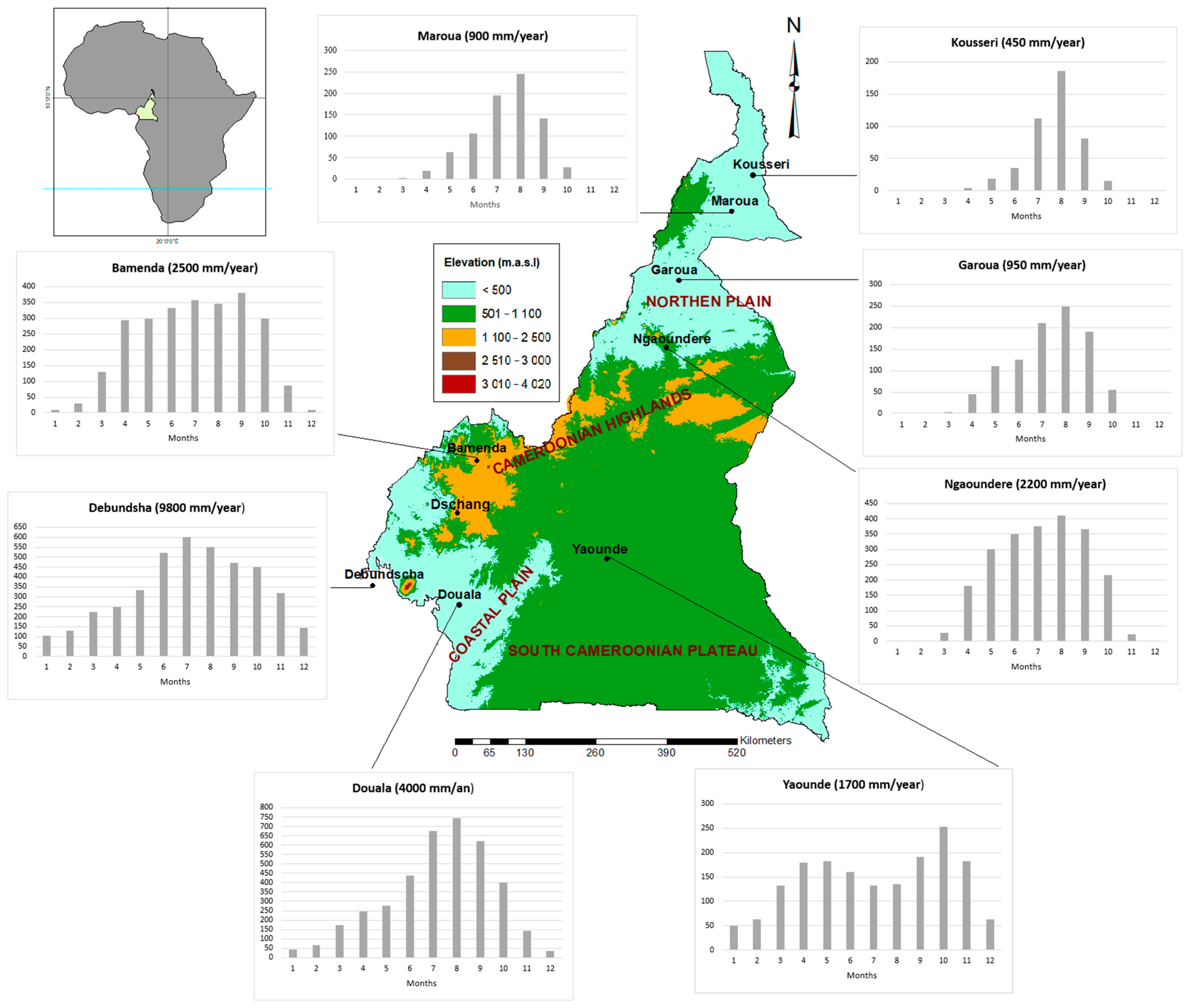

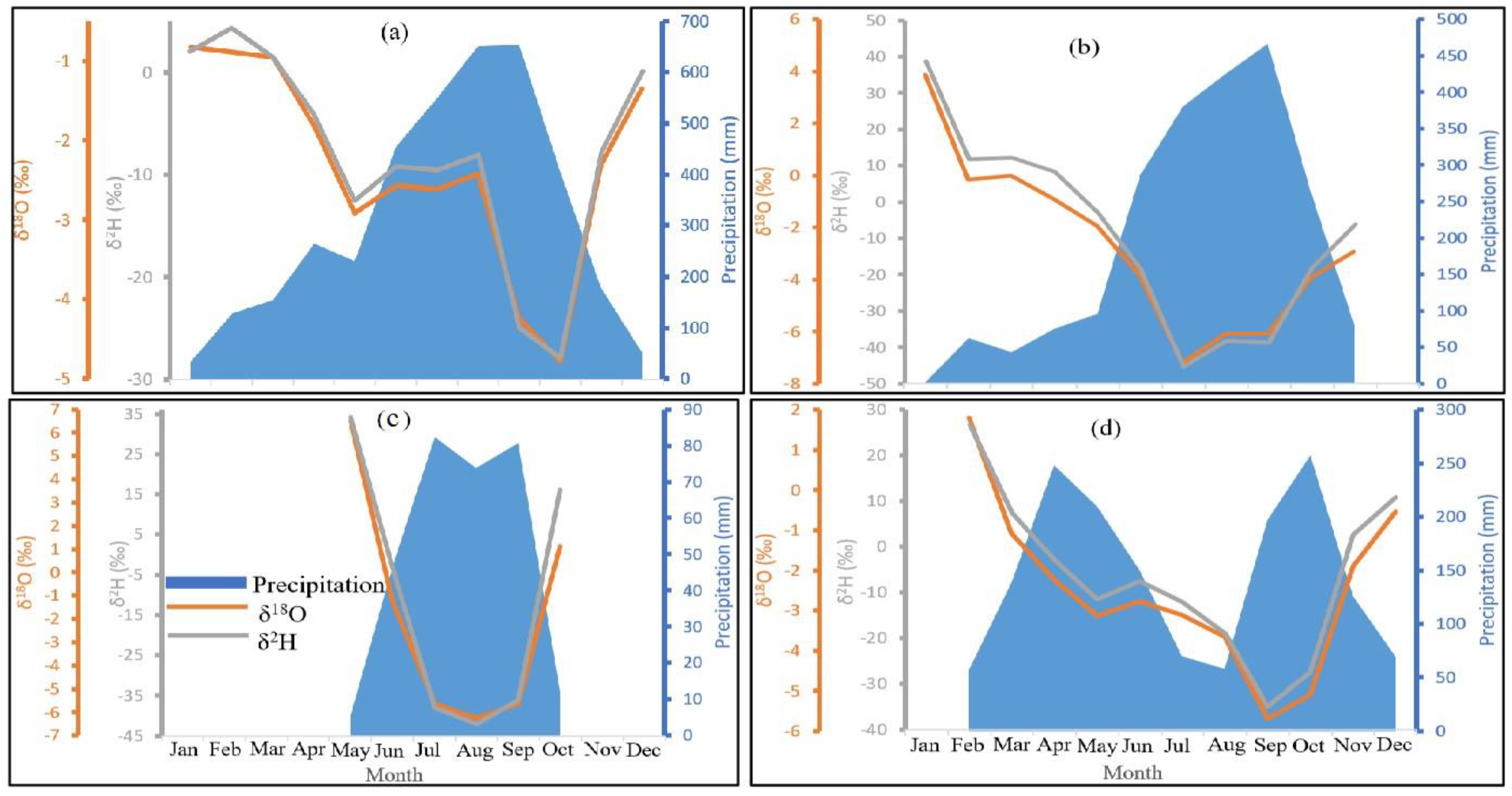
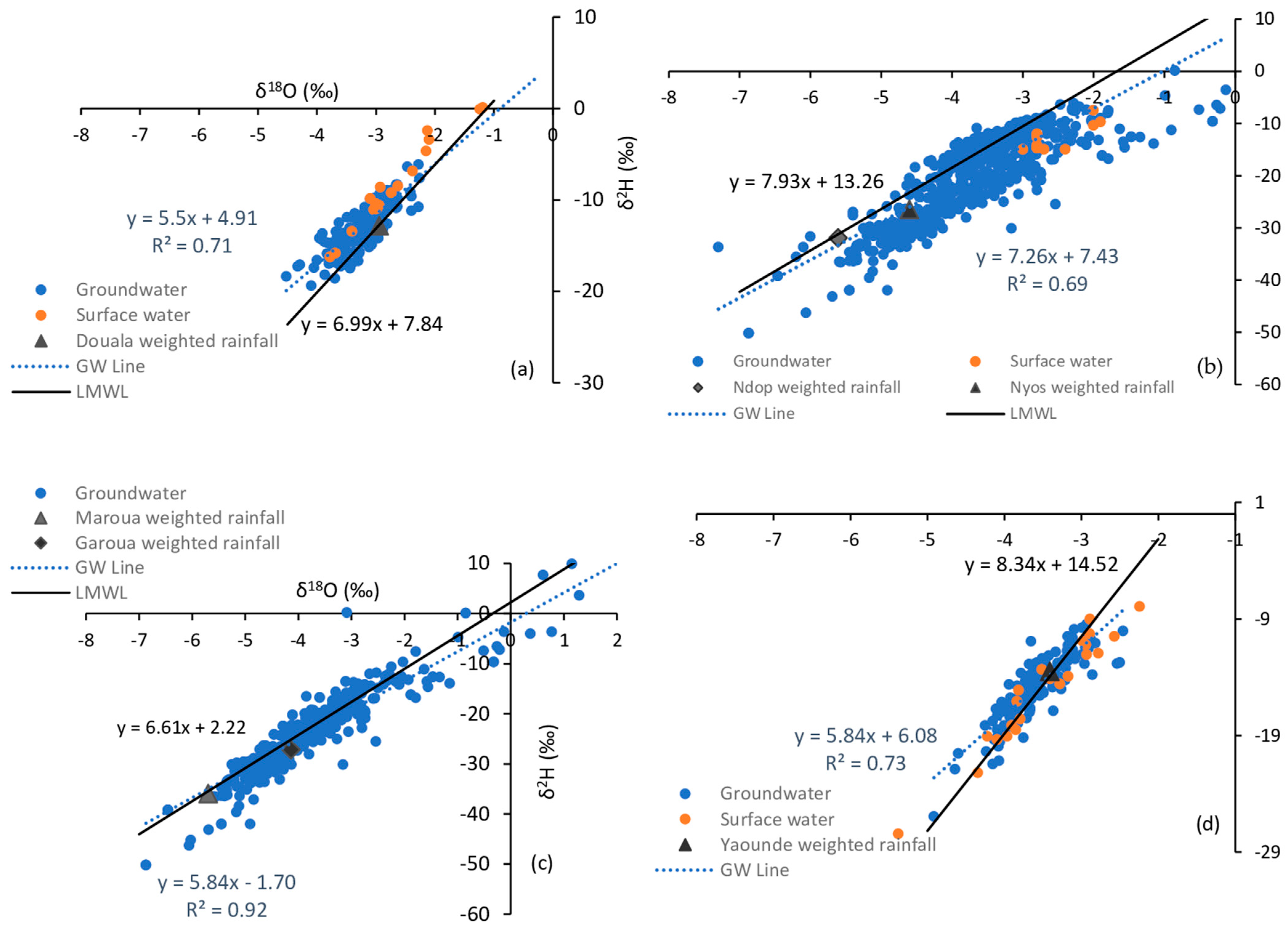

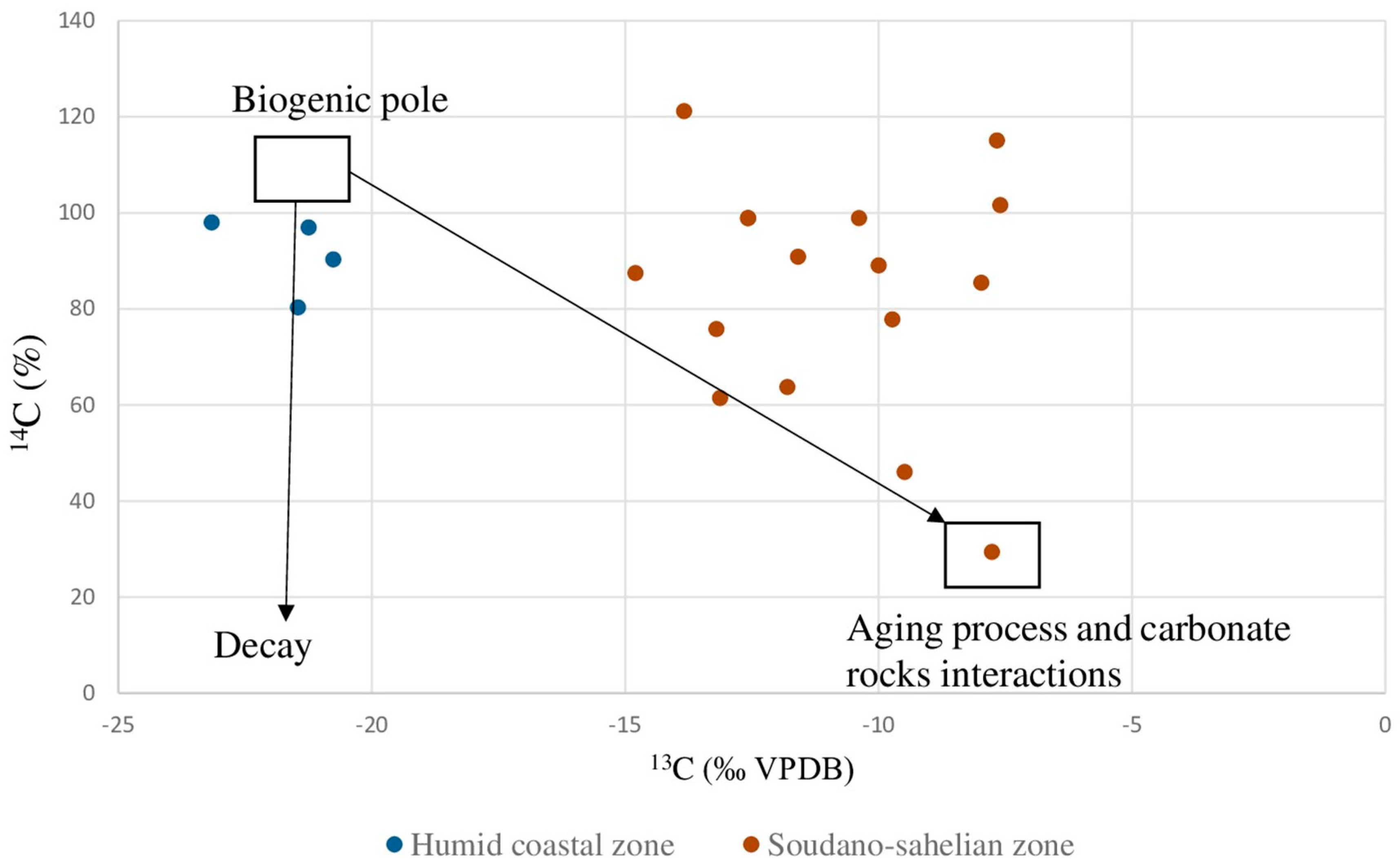
| Geomorpho-Climatic Region | Reference Rainfall Stations | na | Studied Aquifer | nb | References |
|---|---|---|---|---|---|
| Humid coastal areas | Douala Lobe Mundembe | 160 12 12 | Multi-aquifer system (gravels/sands/silts/clays) | 250 6 | [27,28,29,30,31] |
| Volcanics | 41 | [32] | |||
| South plateau | Yaoundé | 35 | Basement | 76 | [21] |
| Highlands | Ndop Nyos | 12 8 | Basement | 58 | [33,34] |
| Northern lowlands | Garoua Maroua | 28 24 | Sandstones Sands | 32 269 | [23,24,35] |
| Station | Lat. (°) | Long. (°) | Alt. (m.a.s.l) | DC * (km) | Record | n | Mean Interannual Meteorological Parameters | Mean Arithmetical Contents | Weighted Mean | LMWL * | |||||||
|---|---|---|---|---|---|---|---|---|---|---|---|---|---|---|---|---|---|
| P * (mm) | T * (°C) | δ18O (‰) | δ2H (‰) | d-Excess (‰) | δ18O (‰) | δ2H (‰) | d-Excess (‰) | Slope | Intercept (‰) | R2 | |||||||
| Douala | 4.04 | 9.73 | 18 | 35 | 2006–2021 | 160 | 3623 | 27.1 | −2.44 | −9.20 | 10.31 | −2.95 | −12.83 | 10.77 | 6.99 | 7.84 | 0.91 |
| Lobe | 5.15 | 9.18 | 60 | 32 | 2012 | 12 | 3189 | 27.2 | −2.82 | −10.00 | 12.57 | −3.69 | −17.53 | 11.96 | 7.97 | 12.48 | 0.95 |
| Mundemba | 4.95 | 8.87 | 30 | 61 | 2012 | 12 | 5067 | 27.3 | −2.49 | −8.47 | 11.41 | −3.47 | −16.17 | 11.62 | 7.75 | 10.79 | 0.95 |
| Yaoundé | 3.86 | 11.46 | 736 | 191 | 2013–2014 2020–2021 | 35 | 1622 | 23.7 | −2.90 | −9.70 | 13.54 | −3.41 | −13.48 | 13.77 | 8.34 | 14.52 | 0.98 |
| Garoua | 9.30 | 12.38 | 250 | 750 | 1991–1992 | 28 | 767 | 27.3 | −4.19 | −28.15 | 5.34 | −5.38 | −27.74 | 5.42 | 8.46 | 7.26 | 0.97 |
| Maroua | 10.59 | 14.32 | 396 | 920 | 2020–2021 | 24 | 516 | 27.8 | −3.03 | −17.85 | 6.42 | −5.70 | −35.90 | 9.71 | 6.61 | 2.22 | 0.96 |
| Ndop | 5.98 | 10.42 | 1178 | 244 | 2014 | 12 | 140 | 25.4 | −2.96 | −10.21 | 13.47 | −5.61 | −31.93 | 12.98 | 7.93 | 13.26 | 0.99 |
| Nyos | 6.48 | 10.29 | 900 | 290 | 2013 | 8 | 335 | 21.7 | −3.33 | −15.70 | 10.90 | −4.60 | −26.48 | 10.30 | 8.38 | 12.15 | 1.00 |
| Water Types | Geomorphoclimatic Domain | n | Sampling Period | δ18O (‰) | δ2H (‰) | D-Excess | |||||||||
|---|---|---|---|---|---|---|---|---|---|---|---|---|---|---|---|
| Min | Max | Mean | St. Dev. | Min | Max | Mean | St. Dev. | Min | Max | Mean | St. Dev. | ||||
| Groundwater | Humid coastal area | 256 | 2011–2017 | −4.52 | −2.03 | −3.23 | 0.3 | −18.4 | −9.3 | −12.85 | 2.03 | 6.51 | 17.76 | 12.45 | 1.80 |
| Highlands | 99 | 2012–2013 | −7.30 | 1.9 | −3.61 | 0.7 | −33.7 | −4.7 | −18.94 | 6.63 | −19.9 | 24.7 | 9.90 | 3.73 | |
| South plateau | 76 | 2020 | −4.92 | −2.46 | −3.60 | 0.30 | −26 | −10 | −14.92 | 2.08 | 7.26 | 18.32 | 13.86 | 1.21 | |
| North lowland | 301 | 1989 and 2015 | −6.87 | 11.03 | −3.67 | 1.02 | −50.2 | 50.3 | −23.17 | 6.87 | −38.0 | 24.9 | 5.9 | 3.24 | |
| Surface water | Humid coastal area | 53 | 2011–2017 | −3.79 | −1.19 | −2.67 | 0.58 | −16.2 | 0.09 | −8.36 | 3.85 | 9.48 | 14.92 | 13 | 1.07 |
| Highlands | 16 | 2012–2013 | −3 | −1.9 | −2.33 | 0.37 | −15 | −7.5 | −12.1 | 2.9 | 4.2 | 9.9 | 7.59 | 1.22 | |
| South plateau | 22 | 2020 | −5.38 | −2.24 | −3.49 | 0.57 | −27.4 | −7.94 | −15.10 | 3.77 | 10.01 | 15.58 | 12.82 | 1.23 | |
| North lowland | 31 | 1989 and 2015 | −2.74 | −1.15 | −1.88 | 0.6 | −20.9 | −12.7 | −15.80 | 0.1 | −4.68 | 3.76 | −1.93 | 0.1 | |
Disclaimer/Publisher’s Note: The statements, opinions and data contained in all publications are solely those of the individual author(s) and contributor(s) and not of MDPI and/or the editor(s). MDPI and/or the editor(s) disclaim responsibility for any injury to people or property resulting from any ideas, methods, instructions or products referred to in the content. |
© 2023 by the authors. Licensee MDPI, Basel, Switzerland. This article is an open access article distributed under the terms and conditions of the Creative Commons Attribution (CC BY) license (https://creativecommons.org/licenses/by/4.0/).
Share and Cite
Nlend, B.; Huneau, F.; Ngo Boum-Nkot, S.; Song, F.; Komba, D.; Gwodog, B.; Meyoupe, P.; Djieugoue, B.; Fongoh, E. Review of Isotope Hydrology Investigations on Aquifers of Cameroon (Central Africa): What Information for the Sustainable Management of Groundwater Resources? Water 2023, 15, 4056. https://doi.org/10.3390/w15234056
Nlend B, Huneau F, Ngo Boum-Nkot S, Song F, Komba D, Gwodog B, Meyoupe P, Djieugoue B, Fongoh E. Review of Isotope Hydrology Investigations on Aquifers of Cameroon (Central Africa): What Information for the Sustainable Management of Groundwater Resources? Water. 2023; 15(23):4056. https://doi.org/10.3390/w15234056
Chicago/Turabian StyleNlend, Bertil, Frederic Huneau, Suzanne Ngo Boum-Nkot, Fricelle Song, David Komba, Bernard Gwodog, Parfait Meyoupe, Boris Djieugoue, and Enoh Fongoh. 2023. "Review of Isotope Hydrology Investigations on Aquifers of Cameroon (Central Africa): What Information for the Sustainable Management of Groundwater Resources?" Water 15, no. 23: 4056. https://doi.org/10.3390/w15234056





